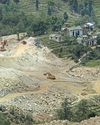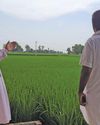The ravines of Chambal used to provide multiple livelihood options for its poor and marginal farmers. Leveling of land is triggering conflicts and increasing social inequity

THE CHAMBAL region in central India is one of the most densely populated regions in the country. It has a very complex socio-economic structure, where more than 80 per cent of the population is primarily dependent on agriculture. The region’s major lifeline is the Chambal River, where nearly 4,800 sq km land has been affected by severely dissected ravines. There are no major industries in the region and alternative livelihood options are also very limited. Therefore, the dependency on land is very high.
A new trend has emerged over the past decades—large parts of the Chambal ravines are being leveled. During the last 40 years, around 600 sq km of these degraded ravines, locally known as bihads, have been leveled in the Chambal region. The intensity of land leveling has enormously increased over the past decade.
The ravines are among the most vulnerable regions in the country. Faced with land erosion and gully formation that shrinks their lands, farmers are opting for various coping mechanisms. These include contour bunding, channelling, gully path modifications, changing cropping patterns, and most importantly, land leveling. With increasing availability of heavy machinery, land leveling has expanded phenomenally.
Bu hikaye Down To Earth dergisinin September 1, 2017 sayısından alınmıştır.
Start your 7-day Magzter GOLD free trial to access thousands of curated premium stories, and 9,000+ magazines and newspapers.
Already a subscriber ? Giriş Yap
Bu hikaye Down To Earth dergisinin September 1, 2017 sayısından alınmıştır.
Start your 7-day Magzter GOLD free trial to access thousands of curated premium stories, and 9,000+ magazines and newspapers.
Already a subscriber? Giriş Yap

A SPRIG TO CARE FOR
Punarnava, a perennial herb, is easy to grow and has huge health benefits

DIGGING A DISASTER
Soapstone mining near Dabti Vijaypur village has caused many residents to migrate.

REVIEW THE TREATMENT
Several faecal sludge treatment plants in Uttar Pradesh suffer from design flaws that make the treatment process both expensive and inefficient

MAKE STEEL SUSTAINABLE
As India works to double its GDP by 2030, its steel industry must balance growth with sustainability. By embracing policies like the Steel Scrap Recycling Policy 2019 and adopting green technologies, India is paving the way for a more sustainable future in steel production

Can ANRF pull off the impossible for India?
Anusandhan National Research Foundation is expected to reorient India's innovation goals but funding issues, old mindsets remain a drag

TROUBLED WOODS
Forests are a great bulwark against climate change. But this is fast changing. AKSHIT SANGOMLA travels through some of the pristine patches of the Western Ghats to explore how natural disturbances triggered by global warming now threaten the forest health

BLINDING GLOW
The science is clear: increased illumination has damaging consequences for the health of humans, animals and plants. It’s time governments introduced policies to protect the natural darkness and improved the quality of outdoor lighting.

GROUND REALITY
What happens when the soil loses the ability to grow healthy, high-yield crops on its own?

GM POLICY MUST BE FARMER CENTRIC
On July 23, the Supreme Court of India directed the Union government to develop a national policy on genetically modified (GM) crops for research, cultivation, trade and commerce through public consultation.

Vinchurni's Gandhi
A 96-year-old farmer transforms barren land into a thriving forest in drought-prone region of Satara